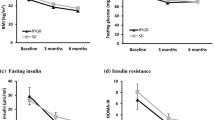Background: Laparoscopic adjustable gastric banding (LAGB) and laparoscopic Roux-en-Y gastric bypass (LRYGBP) both effectively treat the insulin resistance associated with type 2 diabetes mellitus (T2DM). Restriction of caloric consumption, alterations in the entero-insular axis or weight loss may contribute to lowering insulin resistance after these procedures. The relative importance of these mechanisms, however, following LAGB and LRYGBP remain unclear. The aim of this study was to compare directly the short-term changes in insulin resistance following LAGB and LRYGBP in similar populations of patients. Methods: Patient preference determined operation type. The Homeostasis Model Assessment for Insulin Resistance (HOMA IR) was used to measure insulin resistance. Preoperative values were compared to postoperative levels obtained within 90 days of surgery. Significant differences between groups were tested by ANOVA. Results: There were no significant preoperative differences between groups. The 56 LAGB patients had a mean age of 42.5 years (25.7-63), BMI of 45.5 kg/m2 (35-66) and preoperative HOMA IR of 4.1 (1.4-39.2). 75% of LAGB patients were female and 43% had T2DM. The 61 LRYGBP patients had a median age of 39.9 years (22.1-64.3), BMI of 45.0 kg/m2 (36-62), and preoperative HOMA IR of 5.0 (0.6-56.5). 79% of LRYGBP patients were women and 44.3% had T2DM. Median follow-up for LAGB patients was 45 days (18-90) and for LRYGBP patients 46 days (8-88 days). LAGB patients had a median of 14.8% excess weight loss (6.9%-37.0%) and LRYGB patients 24.2% (9.8%-51.4%). Postoperative HOMA IR was significantly less after LRYGBP, 2.2 (0.7-12.2), than LAGB, 2.6 (0.8-29.6), although change in HOMA IR was not significantly different. Change in HOMA IR for both groups did not vary with length of follow-up or weight loss but correlated best with preoperative HOMA IR (LAGB r=0.8264; LRYGBP r=0.9711). Conclusions: Both LAGB and LRYGBP significantly improved insulin resistance during the first 3 months following surgery. Both operations generated similar changes in HOMA IR, although postoperative HOMA IR levels were significantly lower after LRYGBP. These findings suggest that caloric restriction plays a significant role in improving insulin resistance after both LAGB and LRYGBP.
Similar content being viewed by others
Author information
Authors and Affiliations
Rights and permissions
About this article
Cite this article
Ballantyne, G.H., Farkas, D., Laker, S. et al. Short-term Changes in Insulin Resistance following Weight Loss Surgery for Morbid Obesity: Laparoscopic Adjustable Gastric Banding versus Laparoscopic Roux-en-Y Gastric Bypass. OBES SURG 16, 1189–1197 (2006). https://doi.org/10.1381/096089206778392158
Published:
Issue Date:
DOI: https://doi.org/10.1381/096089206778392158




